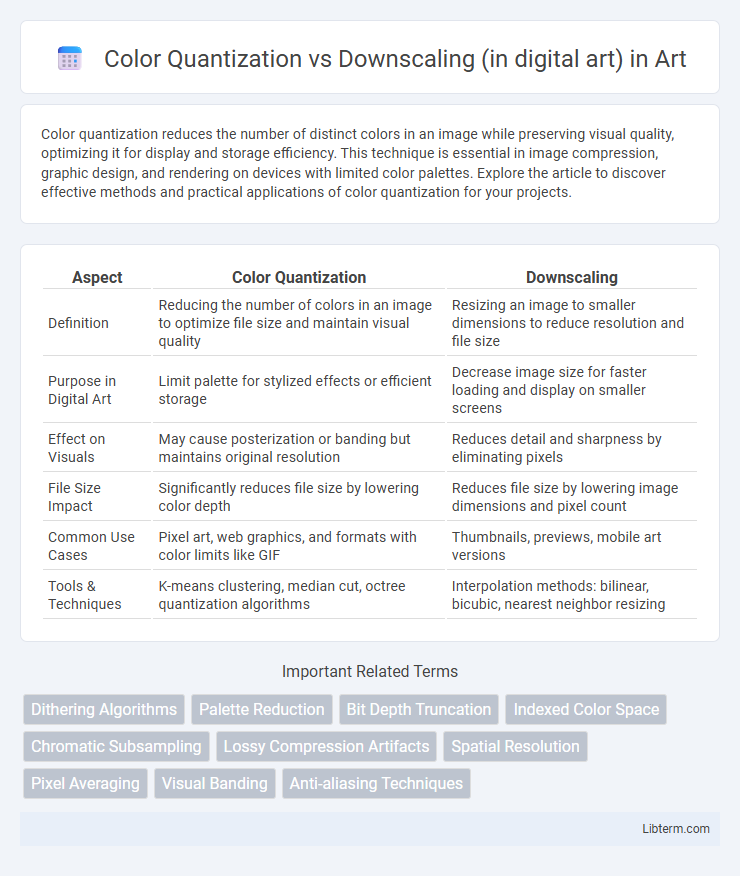Color quantization reduces the number of distinct colors in an image while preserving visual quality, optimizing it for display and storage efficiency. This technique is essential in image compression, graphic design, and rendering on devices with limited color palettes. Explore the article to discover effective methods and practical applications of color quantization for your projects.
Table of Comparison
| Aspect | Color Quantization | Downscaling |
|---|---|---|
| Definition | Reducing the number of colors in an image to optimize file size and maintain visual quality | Resizing an image to smaller dimensions to reduce resolution and file size |
| Purpose in Digital Art | Limit palette for stylized effects or efficient storage | Decrease image size for faster loading and display on smaller screens |
| Effect on Visuals | May cause posterization or banding but maintains original resolution | Reduces detail and sharpness by eliminating pixels |
| File Size Impact | Significantly reduces file size by lowering color depth | Reduces file size by lowering image dimensions and pixel count |
| Common Use Cases | Pixel art, web graphics, and formats with color limits like GIF | Thumbnails, previews, mobile art versions |
| Tools & Techniques | K-means clustering, median cut, octree quantization algorithms | Interpolation methods: bilinear, bicubic, nearest neighbor resizing |
Introduction to Color Quantization and Downscaling
Color quantization reduces the number of distinct colors in a digital image to enable efficient storage and easier processing, typically using algorithms like median-cut or k-means clustering. Downscaling shrinks the image's resolution by decreasing pixel count, preserving overall composition while reducing detail and file size. Both techniques optimize images for digital art by balancing visual quality with performance constraints.
Defining Color Quantization in Digital Art
Color quantization in digital art refers to the process of reducing the number of distinct colors in an image to a limited palette while preserving visual fidelity. This technique is essential in optimizing file size and ensuring compatibility with devices or formats that support fewer colors, such as GIFs or pixel art. Unlike downscaling, which reduces image resolution by decreasing pixel dimensions, color quantization focuses solely on minimizing color information without altering the image's overall size or detail.
Understanding Downscaling and Its Uses
Downscaling in digital art refers to reducing the resolution of an image by decreasing its pixel dimensions, which helps optimize file size and improve loading times while maintaining overall visual clarity. This process is essential for creating web-friendly images, thumbnails, and previews without significant loss of detail or context. Unlike color quantization, which reduces color palette size to minimize file size and complexity, downscaling modifies the image's spatial resolution and provides a balance between image quality and performance efficiency.
Key Differences Between Color Quantization and Downscaling
Color quantization reduces the number of distinct colors in an image to optimize file size and palette constraints, often used in GIFs or pixel art. Downscaling decreases the image resolution by reducing pixel dimensions, impacting image detail and sharpness. Key differences include color quantization altering color depth without changing resolution, while downscaling modifies spatial resolution without necessarily changing color diversity.
When to Use Color Quantization vs Downscaling
Color quantization is best used when reducing the number of colors in an image to optimize file size or match limited palette requirements, such as in pixel art or web graphics. Downscaling is ideal for decreasing image resolution while maintaining color diversity, useful for thumbnails or reducing image dimensions without losing visual detail. Choose color quantization for palette reduction and downscaling for size reduction with retained color fidelity.
Visual Impact on Digital Artworks
Color quantization reduces the number of distinct colors in a digital artwork, creating a stylized, posterized effect that can emphasize shapes and contrasts but may introduce banding and loss of subtle gradients. Downscaling decreases the image resolution, which generally softens details and blends colors, potentially causing a loss of sharpness and texture that affects overall clarity. Both techniques significantly alter the visual impact by either simplifying color complexity or diminishing spatial detail, impacting aesthetics based on the intended artistic expression.
Common Algorithms for Color Quantization
Common algorithms for color quantization in digital art include Median Cut, Octree, and K-Means clustering, each reducing color palettes to manageable sizes while preserving image fidelity. Median Cut partitions color space by recursively subdividing into regions with roughly equal pixel counts, effectively capturing dominant colors. Octree builds a hierarchical tree structure to merge similar colors dynamically, while K-Means iteratively clusters pixel colors to minimize overall color variance, enhancing palette optimization for downscaled images.
Best Practices for Effective Downscaling
Effective downscaling in digital art requires preserving essential image details and minimizing pixelation by using advanced resampling algorithms like Lanczos or bicubic interpolation. Maintaining the original color profile and contrast during downscaling helps retain visual fidelity and prevents color distortion. Implementing a layered approach with careful sharpening or smoothing adjustments post-rescale ensures the artwork remains clear and vibrant at reduced dimensions.
Case Studies: Real-World Applications
Color quantization in digital art reduces the color palette to optimize image size and compatibility, often used in game sprite rendering and GIF animations, preserving distinct color regions for stylistic effects. Downscaling decreases image resolution to improve loading times and performance, common in web graphics and mobile applications where display size and bandwidth are limited. Case studies reveal color quantization's effectiveness in pixel art for maintaining visual clarity, while downscaling is preferred in photographic images for smoother gradients and overall usability on diverse devices.
Final Thoughts: Choosing the Right Technique
Color quantization reduces the number of colors in an image to optimize file size and maintain visual fidelity, ideal for limited color palettes or stylized digital art. Downscaling decreases image resolution to reduce dimensions and file size but can blur details, making it suitable for previews or thumbnails. Selecting between color quantization and downscaling depends on the desired balance between image clarity, color accuracy, and file size constraints in the digital art project.
Color Quantization Infographic

 libterm.com
libterm.com